Perhaps the largest impact that this blog has had on my practice can be seen through my journey of improving my efforts to measure student learning. I officially entered the waters of standards-based grading 2 years ago. If you’ve made it to this blog it’s possible you’re wondering “what’s so wrong with Mr Oldfield’s practices of grading, assessment, and measuring student learning that he needed to begin a journey.” Or you may simply be curious about what standards-based grading means. Regardless of the reason, I’ve taken the opportunity to record, quite often, about my progress towards refining my grading practices. I hesitate to say grading practices because it’s much more than grading.
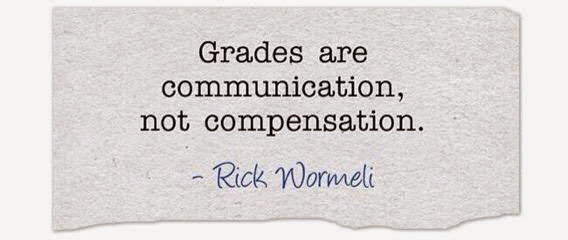
First, it’s necessary to understand that grades are nothing more than communication. Even with poor grading practices, they are still nothing more than communication. Some practices result in better communication than others, but grades are still nothing more than communication. I personally believe grades without consistent, descriptive feedback do a pretty poor job of communicating learning. More on that later.
This post is intended to be about my journey so I’ll try to refrain from pointing out flaws in others’ practices, but you may refer to my own admissions in this post written in Oct of 2013. Since then, a student that follows me on Twitter humorously responded to one of my conversations with other educators about the topic of assessing learning.  In reflection, I’ve cleaned up several bad practices since then. I want to update readers on my current progress and goals moving forward. To remind readers, I teach 8th grade math at a 6-8 middle school in Parkersburg, WV. My wife is a secondary ELA teacher and she often reminds me that in her opinion standards-based learning is more easily adopted in the math classroom because of the skill-building nature of the content. Nonetheless, cultivating learners is something for every classroom. I’ve developed a system where most students practice, with great persistence, to demonstrate proficiency in the targeted skill before they attempt a short assessment. I really don’t incorporate homework, which is more reflective of the blended classroom than my opinion towards homework. I offer them a barrage of data that allows my students to self-assess how ready they are before they sit down to perform on an assessment. I’ll refer you to this old post that includes a piece about how I incorporate data into my classroom, but I’ve added measurement tools since and those tools aren’t reflected in that post. At the time of my previous blog post on grading, I was struggling with the management of student retakes and pacing. That means when students would complete an assessment, but the results indicated they needed more practice in specific areas, I had difficulty managing which assessment that student(s) had completed (version 1, 2, or 3?). I also felt the pressure of maintaining pace (and overall classroom management) once half of my class had completed the assessment with proficiency and the other half was still in the process of improvement. Admittedly, those two or three items were obstacles in the journey. I’ve maintained my practice of providing short, tiered assessments. This means that my assessments are often 4-8 problems. Given the specific content and skill, I try to tier those assessments beginning with the most basic idea I intend to measure (aligned to content standards) and ending with the problem that requires higher ordered tasks such as justifying, analyzing, or application. Designing assessments this way makes me pay special attention to the verbs. I still fight myself to avoid restricting my measurement to verbs like compute and evaluate. In math, these verbs result in items that are easy to measure, but often distort the amount of learning that is communicated. For example, a student may demonstrate proficiency at a high level in evaluating the slope of a line. But if the measurement stops there, neither the teacher or the student will know if he/she can explain the slope/rate of change and y-intercept in the context of a real world situation. See:
In reflection, I’ve cleaned up several bad practices since then. I want to update readers on my current progress and goals moving forward. To remind readers, I teach 8th grade math at a 6-8 middle school in Parkersburg, WV. My wife is a secondary ELA teacher and she often reminds me that in her opinion standards-based learning is more easily adopted in the math classroom because of the skill-building nature of the content. Nonetheless, cultivating learners is something for every classroom. I’ve developed a system where most students practice, with great persistence, to demonstrate proficiency in the targeted skill before they attempt a short assessment. I really don’t incorporate homework, which is more reflective of the blended classroom than my opinion towards homework. I offer them a barrage of data that allows my students to self-assess how ready they are before they sit down to perform on an assessment. I’ll refer you to this old post that includes a piece about how I incorporate data into my classroom, but I’ve added measurement tools since and those tools aren’t reflected in that post. At the time of my previous blog post on grading, I was struggling with the management of student retakes and pacing. That means when students would complete an assessment, but the results indicated they needed more practice in specific areas, I had difficulty managing which assessment that student(s) had completed (version 1, 2, or 3?). I also felt the pressure of maintaining pace (and overall classroom management) once half of my class had completed the assessment with proficiency and the other half was still in the process of improvement. Admittedly, those two or three items were obstacles in the journey. I’ve maintained my practice of providing short, tiered assessments. This means that my assessments are often 4-8 problems. Given the specific content and skill, I try to tier those assessments beginning with the most basic idea I intend to measure (aligned to content standards) and ending with the problem that requires higher ordered tasks such as justifying, analyzing, or application. Designing assessments this way makes me pay special attention to the verbs. I still fight myself to avoid restricting my measurement to verbs like compute and evaluate. In math, these verbs result in items that are easy to measure, but often distort the amount of learning that is communicated. For example, a student may demonstrate proficiency at a high level in evaluating the slope of a line. But if the measurement stops there, neither the teacher or the student will know if he/she can explain the slope/rate of change and y-intercept in the context of a real world situation. See: 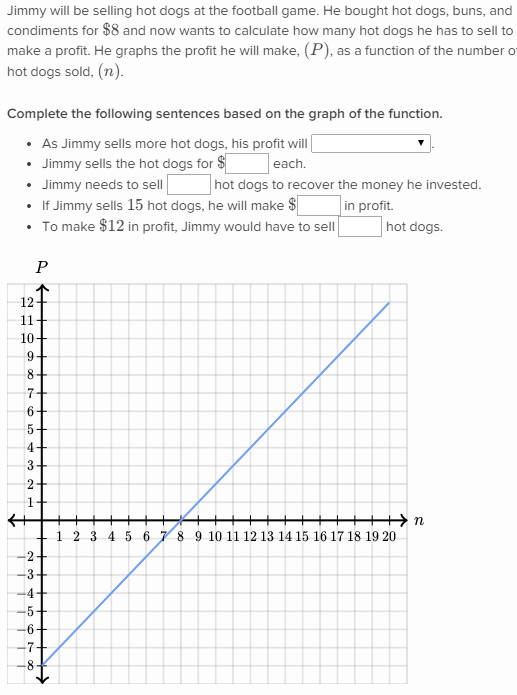
To improve my management of retakes and pacing I transitioned to paperless tests. I began to offer all my assessments on Google Forms. This means that students are provided a URL in order to access my assessments through a web-enabled device. Students input their name at the beginning of each assessment and those results are sent to me immediately in a spreadsheet. I quickly complete the assessment myself under the name Answer Key. This allows me to keep a line in the spreadsheet as the solutions, allowing quick and easy checking of answers once a student completes the assessment. See a screenshot below with the red cells indicating incorrect answers. The yellow line indicates the answer key. Student names have been blurred. Notice the different dates in the timestamp. 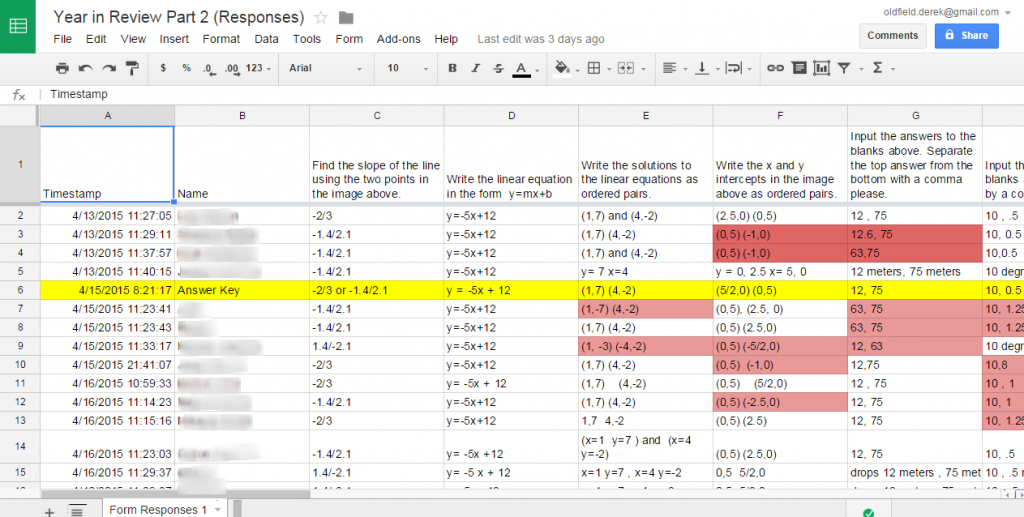 You can see that there are more cells that didn’t show up in the screenshot. These particular results indicate to me areas that my students could use more support and practice. Remember that I try to tier the problems, so the problems at the end of the test require a higher level of thinking in order to complete, which is likely the reason why students got the first couple problems correct. Those problems required the lowest level of understanding, mostly procedural. I conference 1:1 immediately after students complete these assessments. We look at their results next to a blank test and together we work out their mistakes. I have incorporated a practice of requiring students to assign a grade to their test before I even look at their results. Before I went paperless I was using the red/green/yellow stickers you typically see on yard sale items. Students were using the stickers to indicate their own self-evaluation of their results before they submitted the test. On the digital assessments, the last item is always a self-evaluation rubric on which students assign themselves an A-F letter. I believe the feedback provided during the conference, the self-evaluation piece, and the efforts to correct mistakes have made a tremendous impact on the culture of learning in my classroom. The idea I try to align with 100% of the time is where am I now, where am I headed, how do I get there? I make sure students leave the post-assessment conference with an idea of what needs to be done before attempting a retake. The spreadsheet does all the organization that I was previously doing quite poorly. The spreadsheet also offers insight on what questions students are missing the most. I heard someone say once why assess if you aren’t going to do anything with the results?
You can see that there are more cells that didn’t show up in the screenshot. These particular results indicate to me areas that my students could use more support and practice. Remember that I try to tier the problems, so the problems at the end of the test require a higher level of thinking in order to complete, which is likely the reason why students got the first couple problems correct. Those problems required the lowest level of understanding, mostly procedural. I conference 1:1 immediately after students complete these assessments. We look at their results next to a blank test and together we work out their mistakes. I have incorporated a practice of requiring students to assign a grade to their test before I even look at their results. Before I went paperless I was using the red/green/yellow stickers you typically see on yard sale items. Students were using the stickers to indicate their own self-evaluation of their results before they submitted the test. On the digital assessments, the last item is always a self-evaluation rubric on which students assign themselves an A-F letter. I believe the feedback provided during the conference, the self-evaluation piece, and the efforts to correct mistakes have made a tremendous impact on the culture of learning in my classroom. The idea I try to align with 100% of the time is where am I now, where am I headed, how do I get there? I make sure students leave the post-assessment conference with an idea of what needs to be done before attempting a retake. The spreadsheet does all the organization that I was previously doing quite poorly. The spreadsheet also offers insight on what questions students are missing the most. I heard someone say once why assess if you aren’t going to do anything with the results?
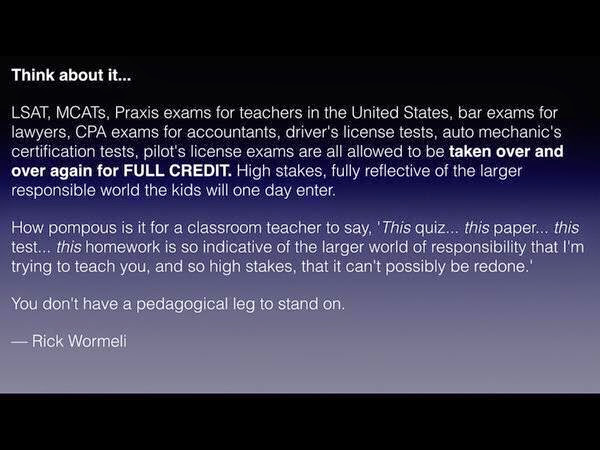 Observation of my classroom would likely look chaotic and unorganized to some. Acknowledging that when the student learns isn’t as important as if that student learns means that I take full advantage of peer to peer interactions to maximize opportunities for students to learn from one another. In a blended classroom like mine, the teacher operates as much more of a facilitator constantly monitoring and managing learning opportunities. This means that I allow data to determine seating arrangements, small group instruction, and peer tutoring arrangements. I believe that the allowance of different paces has benefited all students, particularly those students who would not benefit from strict deadlines on learning.
Observation of my classroom would likely look chaotic and unorganized to some. Acknowledging that when the student learns isn’t as important as if that student learns means that I take full advantage of peer to peer interactions to maximize opportunities for students to learn from one another. In a blended classroom like mine, the teacher operates as much more of a facilitator constantly monitoring and managing learning opportunities. This means that I allow data to determine seating arrangements, small group instruction, and peer tutoring arrangements. I believe that the allowance of different paces has benefited all students, particularly those students who would not benefit from strict deadlines on learning.
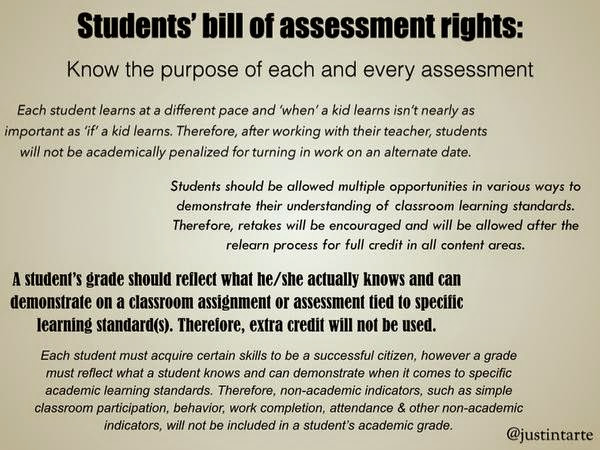 The only scores that I input in our online gradebook are the results of my assessments. These opportunities make up only a small portion of the learning opportunities in class. Many believe that unless class assignments are graded, scored, and recorded, students won’t do them. I make a genuine attempt to provide my students well rounded meals with an emphasis on presentation, rigor, and real-world application. I believe if you provide students an uncommon learning experience they’ll reward you with uncommon effort and attitudes (Dave Burgess).
The only scores that I input in our online gradebook are the results of my assessments. These opportunities make up only a small portion of the learning opportunities in class. Many believe that unless class assignments are graded, scored, and recorded, students won’t do them. I make a genuine attempt to provide my students well rounded meals with an emphasis on presentation, rigor, and real-world application. I believe if you provide students an uncommon learning experience they’ll reward you with uncommon effort and attitudes (Dave Burgess).  I honestly can’t judge or begin to justify what would work in other classrooms, but I believe many of my efforts included in this post and others support the culture of learning that needs to be developed in all classrooms. My students will complete an anonymous survey at the end of the year that will help to provide me feedback about their experience in my classroom. I take those results each year and look at them objectively. They often help determine areas that I need to communicate better to them and their parents.
I honestly can’t judge or begin to justify what would work in other classrooms, but I believe many of my efforts included in this post and others support the culture of learning that needs to be developed in all classrooms. My students will complete an anonymous survey at the end of the year that will help to provide me feedback about their experience in my classroom. I take those results each year and look at them objectively. They often help determine areas that I need to communicate better to them and their parents.  Moving forward, I hope to expand on the variety and quality of opportunities for students to demonstrate learning. I know that my students would benefit from having a variety of ways to demonstrate learning. I have attempted and failed to get my students blogging this year. I have multi-seat desktops in my room. Each multi-seat runs up to 6 other multi-seat units on only 2gb of ram. Despite this, I am grateful for the possibilities this lab provides. It has completely transformed my practice. However, I feel I am limited on the variety of ways my students can demonstrate learning by creating. I would love to incorporate video or audio more often but the technical aspect has eluded me so far. Despite the improved culture in my classroom, my students are still forgetting more than they retain. The blogs were intended to serve as a record of learning, but I found quickly my students didn’t enjoy the writing. I could probably have set that standard a bit higher and cultivated a more enjoyable experience, rather than extra work. There’s got to be a way to incorporate images and typed responses in a manner that would support retention and record learning. Of course, I’m open to suggestions!
Moving forward, I hope to expand on the variety and quality of opportunities for students to demonstrate learning. I know that my students would benefit from having a variety of ways to demonstrate learning. I have attempted and failed to get my students blogging this year. I have multi-seat desktops in my room. Each multi-seat runs up to 6 other multi-seat units on only 2gb of ram. Despite this, I am grateful for the possibilities this lab provides. It has completely transformed my practice. However, I feel I am limited on the variety of ways my students can demonstrate learning by creating. I would love to incorporate video or audio more often but the technical aspect has eluded me so far. Despite the improved culture in my classroom, my students are still forgetting more than they retain. The blogs were intended to serve as a record of learning, but I found quickly my students didn’t enjoy the writing. I could probably have set that standard a bit higher and cultivated a more enjoyable experience, rather than extra work. There’s got to be a way to incorporate images and typed responses in a manner that would support retention and record learning. Of course, I’m open to suggestions!
Thank you for reading this far. I appreciate the opportunity to learn from others and I encourage you to leave a comment if you have any questions or want to provide some input, criticism, or encouragement.
Derek Oldfield
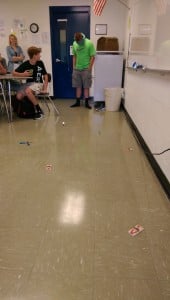
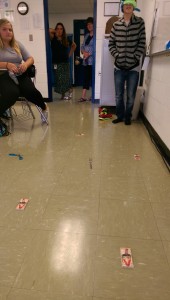 I saw this life changing lesson performed during a church service about three years ago and I have used it in the classroom ever since. I call it a life changing lesson, titled after Dave Burgess’ LCL’s he uses in his classroom (Teach Like A Pirate). I recommend setting the stage with some of Dave’s hooks, like the taboo hook or a mystery box hook. Both of these will add to this amazing experience. I’ve done this for years on days 2 or 3 with my classes. I still don’t know all their names, but they leave with a memorable experience. The experience begins by blindfolding a volunteer at the front of the classroom. It’s necessary that the volunteer take his/her shoes off as it helps increase the suspense or thrill. Obviously, you need enough clear space to establish a point A and point B for the volunteer to travel. Once blindfolded, the teacher will grab his/her bag and begin to pull out mouse traps, knives, forks, scissors (anything that will elicit some gasps from audience). Strategically place the mouse traps and other obstacles out front of the volunteer, creating a maze-like pattern of dangerous obstacles. I do this slowly, while instructing the volunteer to stand very still. I even let a mouse trap or two snap loudly to help build the intensity. Often the volunteer will nervously ask “what was that Mr. Oldfield?” I typically respond “Oh that was nothing. You trust me right?” Anything you can do to help increase the intensity here will help hook the audience and the volunteer. Once the path is set, I explain that the audience will have opportunity to direct the volunteer down the path, but they’ll have to be careful and very specific in their directions. What usually plays out next is a combination of the audience calling out directions, some good and some bad, while I stand next to the volunteer confirming some orders and monitoring his/her safety. Once the volunteer has surpassed one or two obstacles, I will step on one of the mouse traps, setting it off loudly. This normally ignites some anxiety in the volunteer. I kick the trap out of the way and the volunteer continues. Once the volunteer has completed the journey, he/she is allowed to remove the blindfold and look back at the obstacles.
I saw this life changing lesson performed during a church service about three years ago and I have used it in the classroom ever since. I call it a life changing lesson, titled after Dave Burgess’ LCL’s he uses in his classroom (Teach Like A Pirate). I recommend setting the stage with some of Dave’s hooks, like the taboo hook or a mystery box hook. Both of these will add to this amazing experience. I’ve done this for years on days 2 or 3 with my classes. I still don’t know all their names, but they leave with a memorable experience. The experience begins by blindfolding a volunteer at the front of the classroom. It’s necessary that the volunteer take his/her shoes off as it helps increase the suspense or thrill. Obviously, you need enough clear space to establish a point A and point B for the volunteer to travel. Once blindfolded, the teacher will grab his/her bag and begin to pull out mouse traps, knives, forks, scissors (anything that will elicit some gasps from audience). Strategically place the mouse traps and other obstacles out front of the volunteer, creating a maze-like pattern of dangerous obstacles. I do this slowly, while instructing the volunteer to stand very still. I even let a mouse trap or two snap loudly to help build the intensity. Often the volunteer will nervously ask “what was that Mr. Oldfield?” I typically respond “Oh that was nothing. You trust me right?” Anything you can do to help increase the intensity here will help hook the audience and the volunteer. Once the path is set, I explain that the audience will have opportunity to direct the volunteer down the path, but they’ll have to be careful and very specific in their directions. What usually plays out next is a combination of the audience calling out directions, some good and some bad, while I stand next to the volunteer confirming some orders and monitoring his/her safety. Once the volunteer has surpassed one or two obstacles, I will step on one of the mouse traps, setting it off loudly. This normally ignites some anxiety in the volunteer. I kick the trap out of the way and the volunteer continues. Once the volunteer has completed the journey, he/she is allowed to remove the blindfold and look back at the obstacles.









